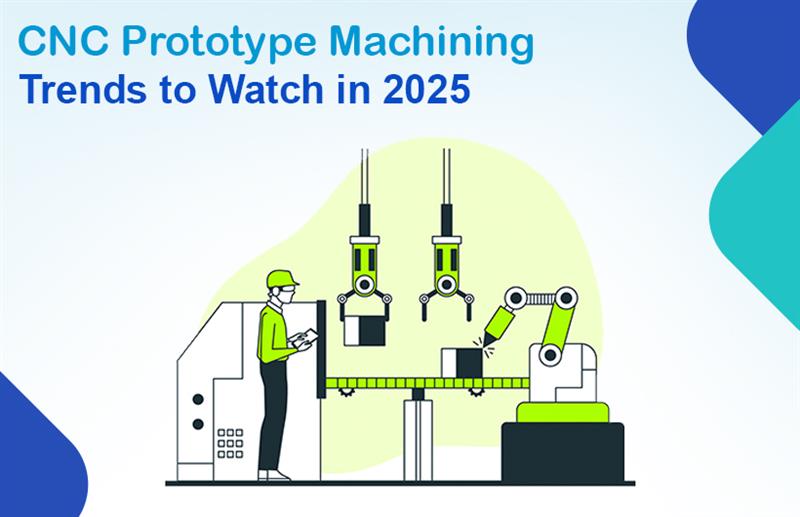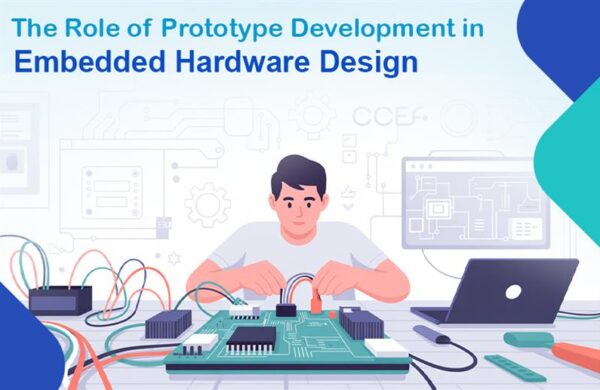The manufacturing landscape is evolving rapidly, and CNC prototype machining is at the forefront of innovation. The evolution of industries toward improved precision and speed and efficiency leads to advanced CNC machining for prototyping systems. The year 2025 will introduce innovative practices that transform CNC rapid prototyping usage between automotive, aerospace, healthcare and consumer electronics industries. This text examines the leading trends that will transform CNC prototype machining as well as approaches businesses can adopt for competitiveness.
Top 7 Trends in CNC Prototype Machining

1. Rise of AI-Driven CNC Machining
CNC machining services experience optimization from Artificial Intelligence (AI), which delivers both improved accuracy and efficiency in their operations. Strategy-driven software applications use real-time data examination to foretell potential failures and modify cutting patterns, thus ensuring improved precision. The advanced automation system decreases waste while speeding up production and minimizing all periods of equipment downtime.
AI-based algorithms help CNC prototype manufacturing services to test designs beforehand so that products achieve better quality standards at reduced material expenses. Companies utilizing AI-driven solutions become effective market leaders because of their capability to deliver reliable and fast prototype services.
2. Expansion of Multi-Axis CNC Machining
The creation of 3-axis CNC production has led manufacturing industries to utilize both 5-axis and 7-axis systems in their operations. The multi-axis CNC prototyping system improves operational effectiveness and decreases manual labor because it simplifies the process of making complex parts.
The manufacturing of complex medical implants along with aerospace parts benefits from multi-axis CNC rapid prototyping because it provides increased precision and enhanced surface quality. The market expects CNC prototype businesses to increase their use of multi-axis equipment to deliver intricate and high-performance prototype products.
3. Integration of IoT in CNC Machining Services
CNC machining services are transforming through IoT technology which allows real-time monitoring that leads to predictive device maintenance. The integration of IoT in CNC machines delivers important data about tool degradation as well as machine operational temperature levels and equipment performance metrics. The connection through networking enables CNC prototype companies to decrease machinery breakdowns so they can improve operational efficiency.
The use of IoT-driven CNC prototyping methods enables smooth operations between design activities with manufacturing stages while improving quality control functions and minimizing total lead time requirements. IoT technology implementation in CNC rapid prototyping production leads organizations to gain both monetary benefits and enhanced operational transparency.
4. Sustainable CNC Prototype Machining
Businesses must adopt sustainability because it has evolved from being optional to being an essential requirement. CNC prototype machining adopts sustainable practices by combining low-waste operations with optimal energy usage as well as environmentally friendly raw material selection. The implementation of minimum quantity lubrication (MQL) alongside better cooling methods represents how CNC machining services work to decrease environmental effects.
The prototyping industry focusing on CNC applications seeks recycled and biodegradable materials as part of global sustainability requirements. The year 2025 will feature sustainability as a fundamental factor when performing CNC prototyping operations since businesses strive for environmentally friendly solutions.
5. Hybrid Manufacturing: Combining CNC with Additive Manufacturing
A revolutionary step forward comes from the combination of CNC machining services and additive manufacturing (3D printing). CNC rapid prototyping systems achieve superior design potential together with better material usage through their integration of subtractive and additive manufacturing operations.
The production sequence at a CNC prototype company includes starting with 3D printing technology to produce rough prototypes that can be completed through CNC machining for prototyping with precise details and tight tolerances. Production expenses get reduced and product development times decrease significantly through this combined manufacturing technique, which establishes itself as a leading approach in 2025.
6. High-Speed CNC Machining for Prototyping
The competitive nature of the present market demands swift operations, and high-speed CNC machining for creating prototypes has started to surge in popularity. Modern CNC equipment operating with elevated rotational speeds and quick tool interchange features enables CNC rapid prototyping to achieve time-efficient results without losing precision standards.
The need for brisk product delivery supports consumer electronics companies and automakers to strongly leverage CNC machining services because of their fast processing capabilities. The integration of high-speed machine technology in CNC prototype development enables companies to provide rapid manufacturing services to their clientele.
7. Automation and Smart CNC Factories
The development of automated technology led to the creation of CNC prototype machining systems that can operate independently. Smart CNC factories increase production figures through AI-quality checks that combine with robotic arms to minimize personnel requirements.
CNC machining services achieve production optimization and standardized results at lower operating costs through the combination of machine learning and robotics applications. CNC prototype manufacturers will rapidly embrace smart manufacturing systems for operational advancement in the period from 2025 to 2025.
8. Advanced Materials in CNC Rapid Prototyping
The progression of CNC prototype manufacturing has accelerated because new materials have entered the market. New advanced composite materials, together with improved polymers, are gradually replacing the existing metals aluminum titanium stainless steel during their industrial applications. Materials that excel in strength characteristics also offer heat resistance combined with lightweight properties and represent the best choice for CNC machining in prototype creation.
Prolific companies creating CNC prototypes from modern materials build enhanced elements that provide ideal solutions to current industrial problems while showcasing superior weight-to-performance ratios.
Final Thoughts
CNC prototype machining development occurs through three distinct paths which consist of innovation combined with automation features alongside sustainable development approaches. The growth of industries requires CNC machining to make prototypes because it creates accurate components at faster speeds.
Technology-driven industry transformations will occur because of AI-enabled CNC rapid prototyping systems working alongside IoT-connected CNC machining operations. Business entities must implement advanced CNC prototype machining solutions to uphold their market leadership position in the year 2025.
If you’re seeking top-tier CNC machining services that incorporate the latest technologies, Monarch Innovation is your go-to CNC prototype company. Whether you need CNC rapid prototyping, advanced material solutions, or high-speed CNC machining for prototyping, Monarch Innovation ensures precision, efficiency, and innovation in every project. Contact us today to bring your ideas to life!






